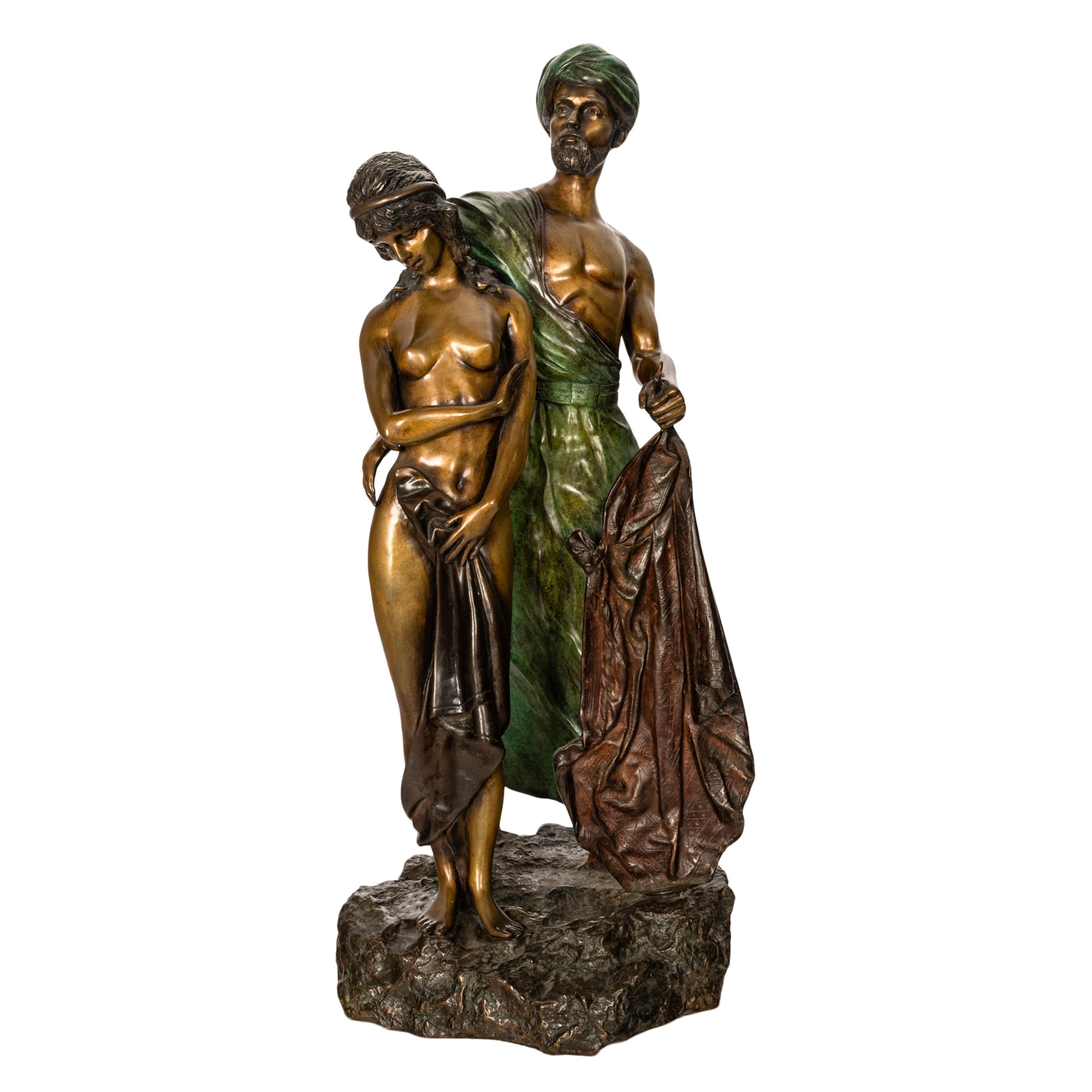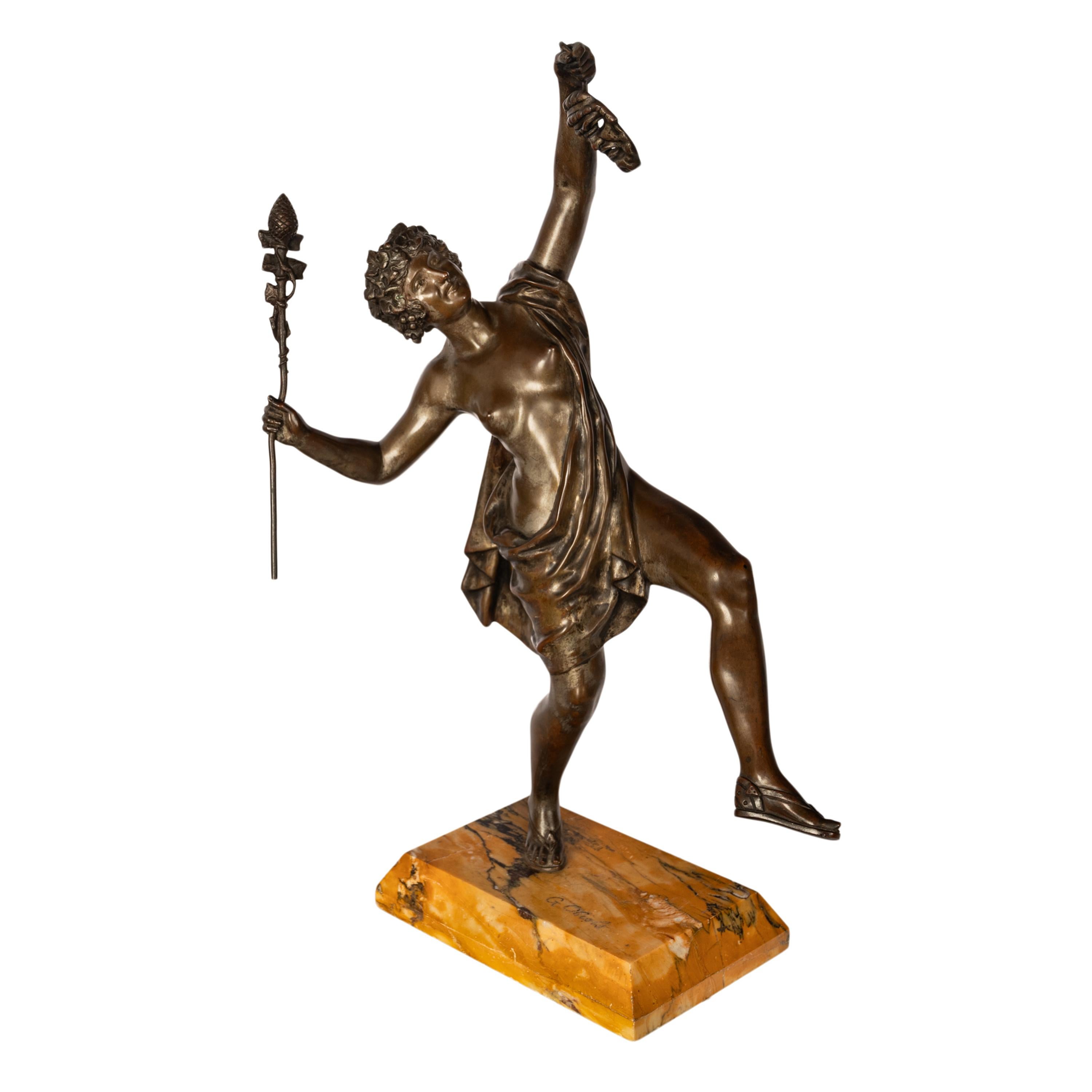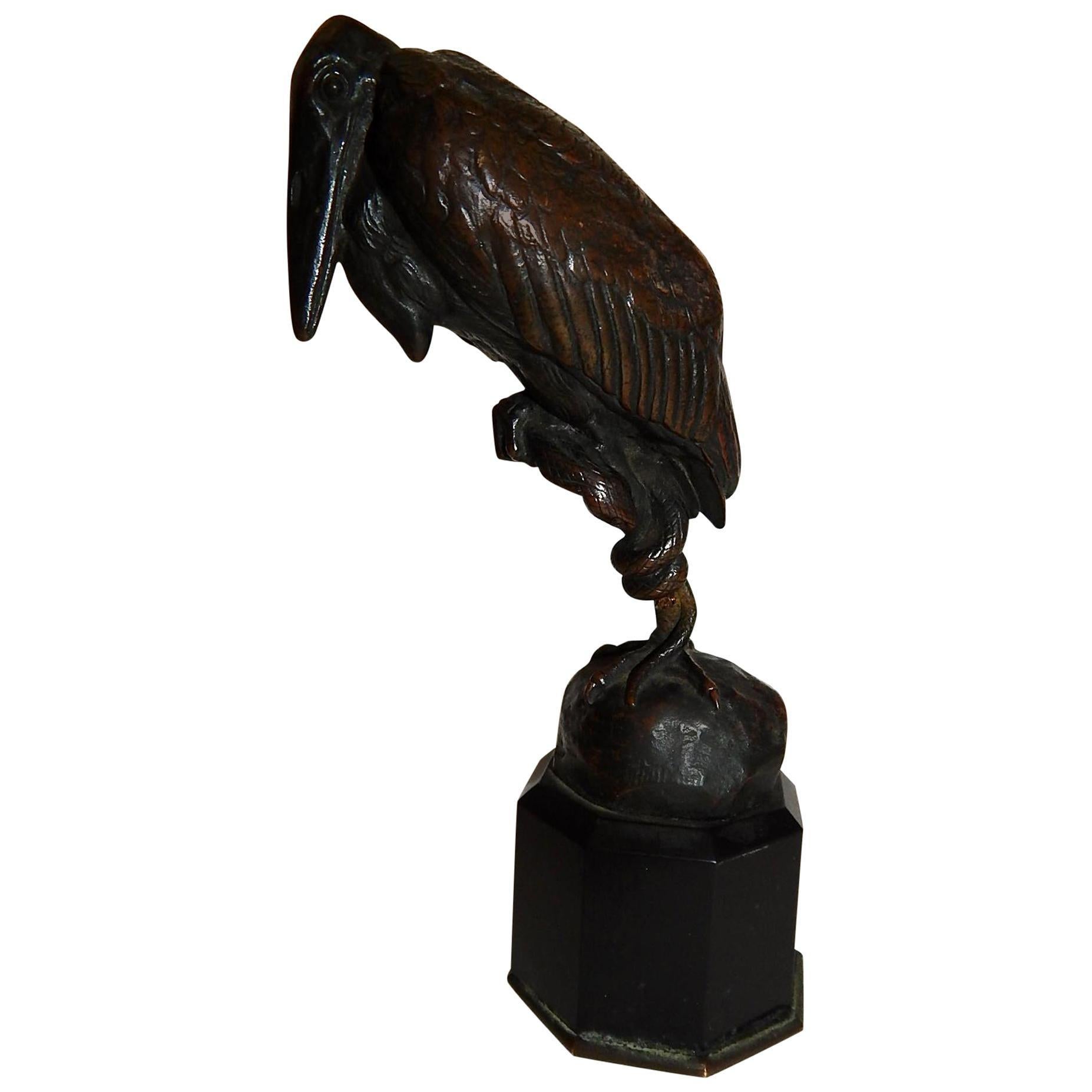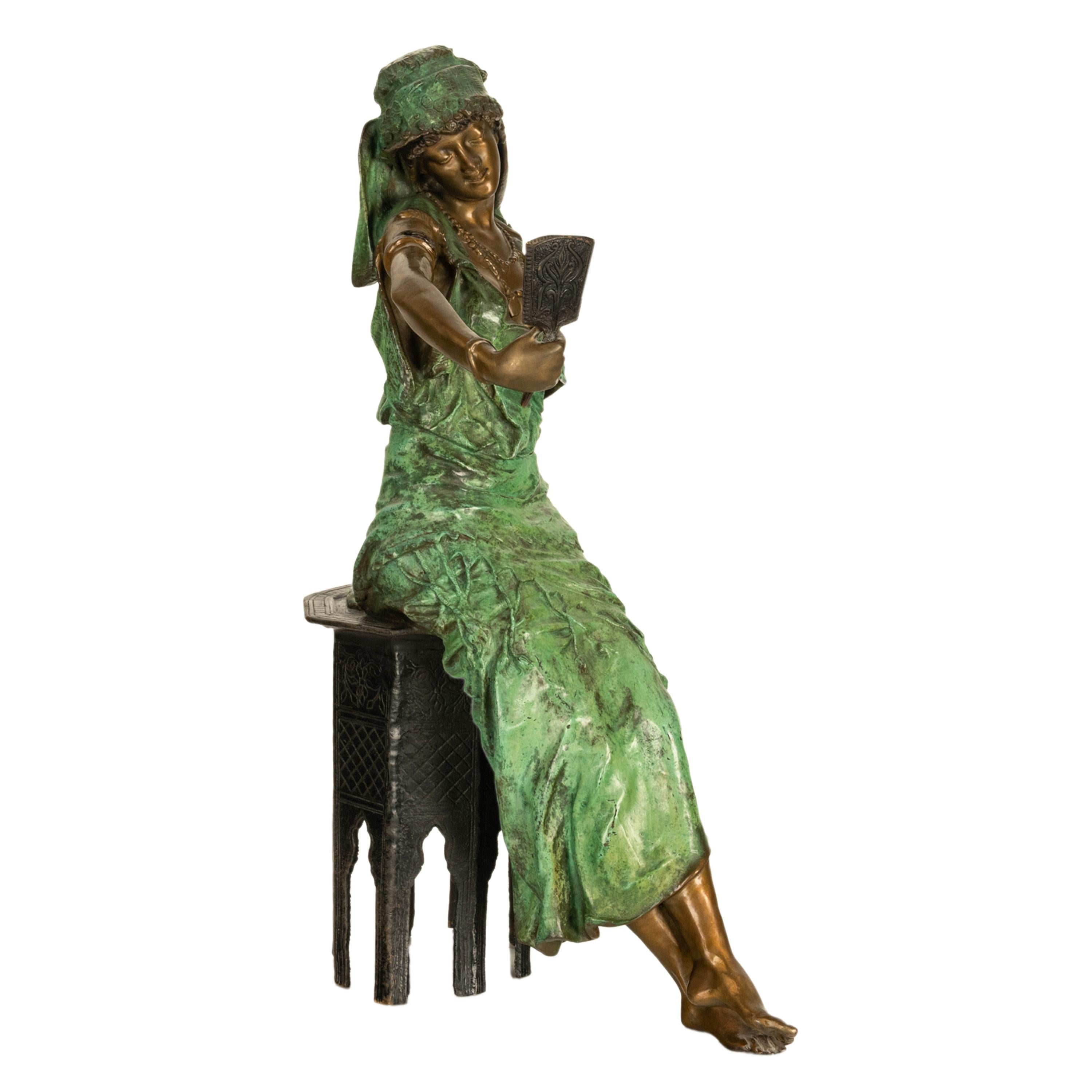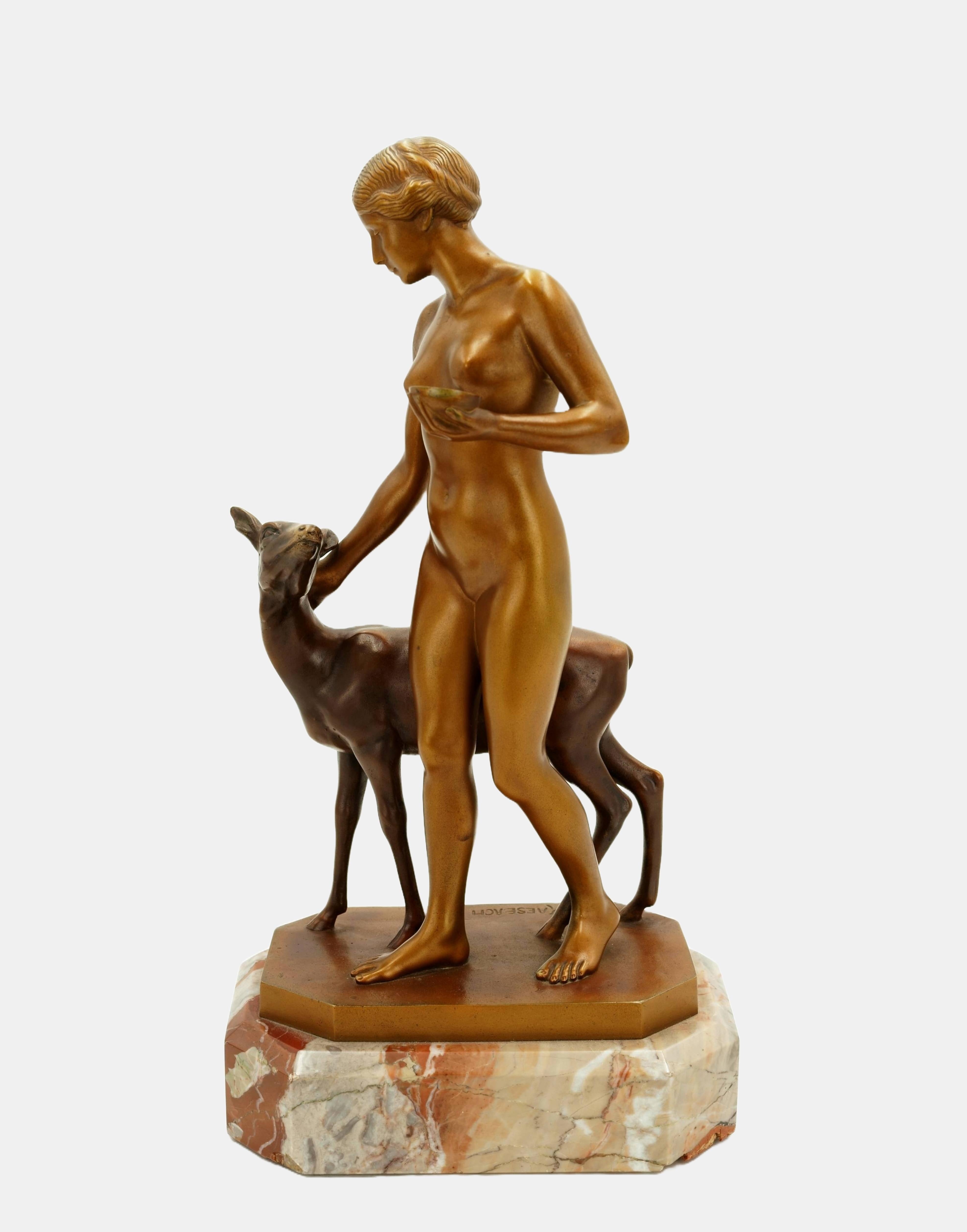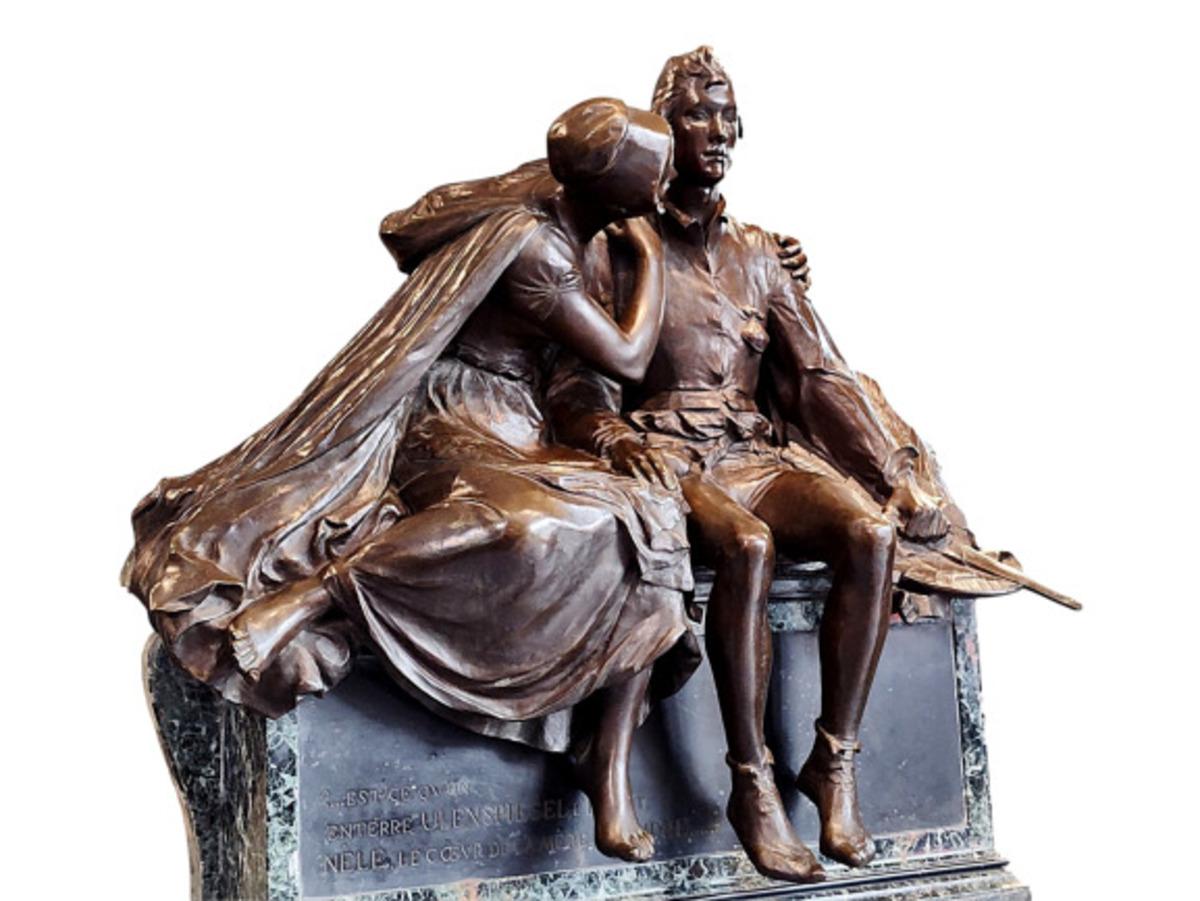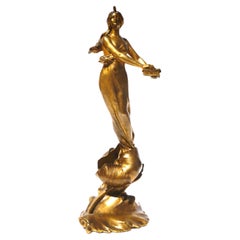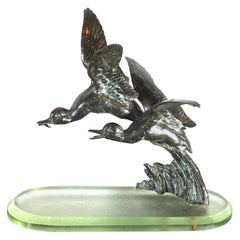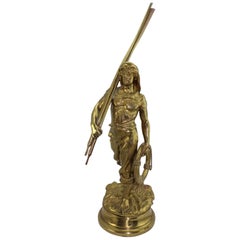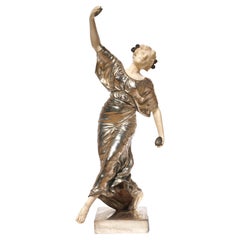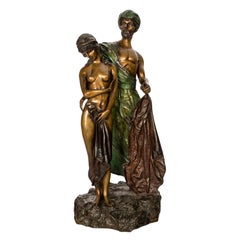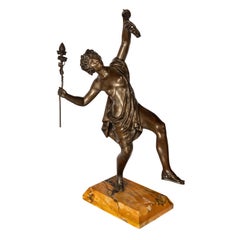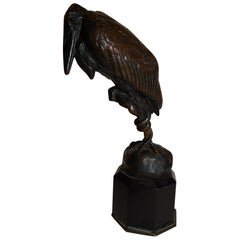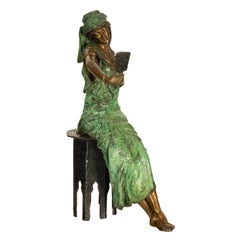Items Similar to Maurice Bouval Gilt and Silvered Bronze Art Nouveau Figure
Want more images or videos?
Request additional images or videos from the seller
1 of 9
UnknownMaurice Bouval Gilt and Silvered Bronze Art Nouveau Figure1900
1900
About the Item
Maurice Bouval
French Art Nouveau Gilt and Silvered Bronze Figural Vide Poche
Cast from a model by Maurice Bouval, cast by Jollet & Cie., Paris, circa 1900
Modeled as a maiden in a standing pose lifting the upper end of her garment to form a wide shallow pocket or vide pouche.
Inscribed M. Bouval and stamped with the foundry seal.
Height 10.8 inches. Width: 5.5 Inches
Provenance: C Estate of Steven and Anne Ausnit
Condition: Wear and tarnishing to silvering and patina
AVANTIQUES is dedicated to providing an exclusive curated collection of Fine Arts, Paintings, Bronzes, Asian treasures, Art Glass and Antiques. Our inventory represents time-tested investment quality items with everlasting decorative beauty. We look forward to your business and appreciate any reasonable offers. All of our curated items are vetted and guaranteed authentic and as described. Avantiques only deals in original antiques and never reproductions. We stand behind our treasures with a full money back return policy if the items are not as described.
Please also consider Avantique’s eclectic bronze collection including Barye, Barrias, Mene, Moigniez, Paillet, Paillard, Fratin, Picault, Tiffany Studios, and Cain among others. We strive to collect the highest quality sculptures in exceptional condition.
- Creation Year:1900
- Dimensions:Height: 10.8 in (27.44 cm)Width: 5.5 in (13.97 cm)Depth: 4.5 in (11.43 cm)
- Medium:
- Movement & Style:
- Period:
- Condition:
- Gallery Location:Dallas, TX
- Reference Number:1stDibs: LU2724214281912
About the Seller
No Reviews Yet
Vetted Professional Seller
Every seller passes strict standards for authenticity and reliability
1stDibs seller since 2024
- ShippingRetrieving quote...Shipping from: Dallas, TX
- Return Policy
Authenticity Guarantee
In the unlikely event there’s an issue with an item’s authenticity, contact us within 1 year for a full refund. DetailsMoney-Back Guarantee
If your item is not as described, is damaged in transit, or does not arrive, contact us within 7 days for a full refund. Details24-Hour Cancellation
You have a 24-hour grace period in which to reconsider your purchase, with no questions asked.Vetted Professional Sellers
Our world-class sellers must adhere to strict standards for service and quality, maintaining the integrity of our listings.Price-Match Guarantee
If you find that a seller listed the same item for a lower price elsewhere, we’ll match it.Trusted Global Delivery
Our best-in-class carrier network provides specialized shipping options worldwide, including custom delivery.More From This Seller
View AllMaurice Bouval Art Nouveau Gilt Bronze Sculpture
Located in Dallas, TX
Maurice Bouval (Fr. 1863-1916) Art Nouveau sculpture.
French Art Nouveau Gilt-Bronze Figure of a Woman
Cast by E. Colin & Cie., Paris, circa 1900
Possibly Pandora, modeled rising ou...
Category
Early 1900s Art Nouveau Figurative Sculptures
Materials
Bronze
Maximilien-Louis Fiot Bronze Ducks In Flight Sculpture
Located in Dallas, TX
Maximilien-Louis Fiot (1886-1953) Art Nouveau-Art Deco sculpture of Ducks in Flight, patinated cast bronze sculpture mounted on thick Acid etched gl...
Category
1910s Art Nouveau Figurative Sculptures
Materials
Bronze
Antoine Bofill Bronze of a Sea Man with Oars, French, circa 1900
By Antoine Bofill
Located in Dallas, TX
This larger than life gold gilded bronze of a sea man with oars will decorate any area and be a great conversation piece. The composition and casting detail are amazing. This is the ...
Category
Early 1900s Art Nouveau Figurative Sculptures
Materials
Bronze
Spanish Art Nouveau Silvered Bronze by Gustavo Obiols
Located in Dallas, TX
Gustavo Obiols Delgado (1858-1910) – Spanish sculptor
Signed in the cast ‘G. Obiols’
Spanish Dancer with Castanetas; Silvered bronze and finely carved bone
No damage or repairs.
H...
Category
1920s Art Nouveau Figurative Sculptures
Materials
Bronze
Louis Ernest Barrias Nature Revealing Herself
By Louis Ernest Barrias
Located in Dallas, TX
Louis Ernest Barrias (French 1841-1905)
Nature Revealing Herself
La Nature se dévoilant devant la Science
Gilt, and silver patinated bronze with blue glass scarab
Signed on base “E...
Category
Early 1900s Art Nouveau Figurative Sculptures
Materials
Bronze
Agathon Leonard Silvered Bronze Of Marguerite
By Agathon Léonard
Located in Dallas, TX
Agathon Leonard (French, 1841 - 1923) Art Nouveau Silvered Bronze
A French Art Nouveau gilt bronze sculpture, "Marguerite", by Agathon Léonard of Margeruite, placing a flower in her...
Category
1890s Art Nouveau Figurative Sculptures
Materials
Bronze
You May Also Like
Antique Orientalist Arab Slave Trader Female Nude Group Cold Painted Bronze 1910
By Franz Bergmann
Located in Portland, OR
A very large 24" (61cm) Franz Xavier Bergmann (1861-1936) cold painted bronze group statue, signed, Austria, circa 1910.
The bronze in the Orientalist manner & depicts a young slave ...
Category
1910s Art Nouveau Figurative Sculptures
Materials
Bronze
Antique Spanish Art Nouveau Bronze Neo-Classical Sculpture Statue Bacchante 1890
Located in Portland, OR
A very good antique Neo-Classical bronze of a Bacchante or Maenad, by Spanish sculptor Gustave Obiols Delgado (1858-1902). The sculpture circa 1890.
This large & very attractive, fin...
Category
1890s Art Nouveau Figurative Sculptures
Materials
Marble, Bronze
Barye Rare Bronze Sculpture, "Marabou and Snake Marabout Au Serpent"
By Antoine-Louis Barye
Located in Phoenix, AZ
Antoine-Louis Barye (1796-1875.) Bronze maribou stork and snake with rich brown patina, signed “Barye” on the embankment.
Antique edition cast marked F. Barbedienne Fondeur (caster.)...
Category
Early 20th Century Art Nouveau Figurative Sculptures
Materials
Bronze
Antique Italian Art Nouveau Coldpainted Bronze Orientalist Figure Arab Girl 1900
Located in Portland, OR
A very large & finely modeled antique Italian cold-painted Orientalist bronze of a young Arab girl, by the Italian sculptor Ferdinando de Luca, circa 1900.
Ferdinando de Luca (also k...
Category
Early 1900s Art Nouveau Figurative Sculptures
Materials
Bronze
Forest idyll / - Soulmate -
By Rudolf Kaesbach
Located in Berlin, DE
Rudolf Kaesbach (1873 Gladbach - 1955 Berlin), Forest idyll, around 1915. Bronze, gold and golden brown patina, with cast plinth, mounted on a marble base (5 cm high), total height 36 cm, dimensions of the bronze: 31 cm (height) x 17 cm (length) x 12 cm (width). Weight 4,6 kg, signed on the plinth "R.[udolf] KAESBACH".
- a few rubbed areas, overall in excellent condition for its age
- Soulmate -
The bronze sculpture depicts a young woman in an intimate exchange with a deer that accompanies her. The animal pauses to turn toward her, while the nude beauty slows her pace to look into the deer's eyes and tenderly caress it with her hand. The woman and the deer are in inner harmony. Even though her lips remain motionless, she speaks the language of the animal with which she is deeply connected.
The golden patina, which contrasts with the more naturalistic coloring of the deer, gives the young woman the appearance of a saint, even if she cannot be identified as such. At the same time, she evokes memories of Diana, the goddess of the hunt, or a nymph. But she lacks the ferocity. In her innocent naivety, she is more like a vestal virgin, who is not at home in the solitude of the forest. And yet, the young beauty, moving unclothed in the heart of nature, looks like a priestess with her hair tied up and a carefully carried bowl on her way to a sacred grove.
In order to open up the above-mentioned associations, Kaesbach deliberately designed the female figure in such a way that she cannot be identified as a specific person. He has created an allegory of natural femininity, characteristic of Art Nouveau, in which the deer is far more than a companion animal. It displays the same gracefulness as the young woman, and the inner resemblance between the two makes the deer appear as her other self. In animal terms, it embodies her inner being, which also gives the deer an allegorical character.
About the artist
Rudolf Kaesbach studied sculpture at the Hanau Academy and worked in a bronze foundry in Paris in 1900. In order to work as an independent artist, he opened a workshop in Düsseldorf, where he cast bronzes from models he designed. In 1902 he made his debut at the German National Art Exhibition in Düsseldorf. The following year Kaesbach went to the academy in Brussels. There he was inspired by contemporary Belgian sculpture, especially the work of Constantin Meunier. He moved to Berlin, where he opened a studio in the villa district of Grunewald and devoted himself to life-size marble sculptures and the design of bronzes. From 1911, he regularly presented his works at the major art exhibitions in Berlin, as well as in Düsseldorf and Malmö. Between 1936 and 1939, he also created models for the Rosenthal porcelain factory. From 1939 to 1944, Kaesbach was represented at the major German art exhibitions in Munich.
GERMAN VERSION
Rudolf Kaesbach (1873 Gladbach - 1955 Berlin), Waldidyll, um 1915. Gold und goldbraun patinierte Bronze mit gegossener Plinthe, auf einem Marmorsockel montiert (5 cm Höhe), Gesamthöhe 36 cm, Maße der Bronze: 31 cm (Höhe) x 17 cm (Länge) x 12 cm (Breite). Gewicht 4,6 kg, auf der Plinthe mit „R.[udolf] KAESBACH“ signiert.
- vereinzele beriebene Stellen, insgesamt in einem altersgemäß ausgezeichneten Zustand
- Seelenverwandtschaft -
Die Bronzeplastik veranschaulicht eine junge Frau im innigen Austausch mit einem sie begleitenden Reh. Das Tier hält inne, um sich zu ihr hochzuwenden, während die nackte Schönheit ihren Schritt verlangsamt, um dem Reh ebenfalls in die Augen zu schauen und es zärtlich mit der Hand zu liebkosen. Die Frau und das Reh sind in einem inneren Gleichklang. Auch wenn ihre Lippen unbewegt bleiben, spricht sie die Sprache des Tieres, mit dem sie auf eine tief empfundene Weise verbunden ist.
Die im Kontrast zur naturalistischeren Einfärbung des Rehs aufstrahlende goldfarbene Patina lässt die junge Frau wie eine Heilige erscheinen, auch wenn sich nicht als Heilige identifizierbar ist. Zugleich ruft sie Erinnerungen an die Jagdgöttin Diana oder eine Nymphe hervor. Dafür fehlt ihr allerdings die Wildheit. In ihrer unschuldigen Naivität gemahnt sie vielmehr an eine Vestalin, die freilich nicht in der Waldeinsamkeit zu Hause ist. Und doch wirkt die sich unbekleidet im Herzen der Natur bewegende junge Schönheit wie eine Priesterin, die sich mit hochgebundenem Haar und der vorsichtig getragenen Schale und dem Wege zu einem Heiligen Hain befindet.
Um die gennannten Assoziationen zu eröffnen, hat Kaesbach die Frauenfigur bewusst so gestaltet, dass sie nicht als konkrete Person identifizierbar ist. Damit hat er eine für den Jugendstil charakteristische Allegorie natürlicher Weiblichkeit geschaffen, bei der das Reh weit mehr als ein Begleittier ist. Es weist dieselbe grazile Anmut wie die junge Frau auf und der innere Gleichklag der beiden lässt das Reh als ihr anderen Ich erscheinen. Es verkörpert – ins Animalische übertragen - ihr inneres Wesen, wodurch auch dem Reh ein allegorischer Charakter zukommt.
zum Künstler
Rudolf Kaesbach studierte an der Akademie Hanau Bildhauerei und war im Jahr 1900 in einer Pariser Bronzegießerei tätig. Um sich als eigenständiger Künstler betätigen zu können, eröffnete er in Düsseldorf eine Werkstatt, in der er Bronzen nach selbstentworfenen Modellen goss. 1902 debütierte er auf der Deutschen Nationalen Kunstaustellung in Düsseldorf. Im Folgejahr ging Kaesbach an die Akademie nach Brüssel. Dort wurde er von der zeitgenössischen belgischen Bildhauerei, insbesondere vom Werk Constantin Meuniers, inspiriert. Zurückgekehrt zog er nach Berlin, wo er im Villenviertel Grunewald ein Atelier eröffnete und sich neben dem Entwurf für Bronzen der lebensgroßen Marmorbildhauerei widmete. Ab 1911 präsentierte er seine Werke regelmäßig auf den Großen Berliner Kunstausstellungen, aber auch in Düsseldorf und Malmö. Zwischen 1936 und 1939 fertigte er zudem Modelle für die Porzellan-Manufaktur Rosenthal an. Von 1939 bis 1944 war...
Category
1910s Jugendstil Nude Sculptures
Materials
Bronze
Thyl Ulenspiegel et Nele – Reduction of the Monument to Charles De Coster
Located in Gent, VOV
Charles Samuel – Thyl Ulenspiegel and Nele (after the Monument to Charles De Coster, 1894) Bronze, marble base, 66 x 61 x 27 cm Cast by Petermann, Brussels A moment of intimacy and d...
Category
20th Century Art Nouveau Figurative Sculptures
Materials
Marble, Bronze
Recently Viewed
View AllMore Ways To Browse
Eclectic Art
Eclecticism Art
Curated Items
Paris Art Bronze
Glass And Bronze Sculpture
Art Nouveau Original Antiques
French Art Nouveau Sculpture
Figural Art Nouveau
Art Nouveau Glass With Bronze
Art Nouveau Bronze Sculptures
Tiffany Art Nouveau
Art Nouveau Bronze Gilt
Art Glass Seal
Glass And Bronze Sculpture French
Reproduction Bronze Sculpture
Gilt Seal
Barye Bronze
Barye Bronze Sculptures
